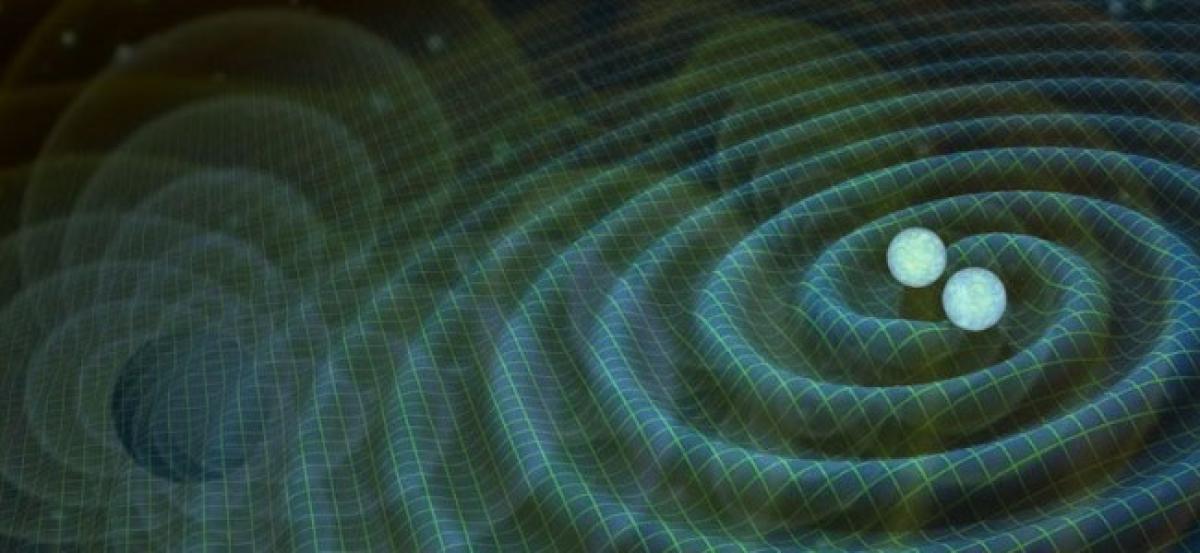Live
- Additional Collector Conducts Surprise Visit to Boys' Hostel in Wanaparthy
- Punjab hikes maximum state-agreed price for sugarcane, highest in country
- Centre okays PAN 2.0 project worth Rs 1,435 crore to transform taxpayer registration
- Punjab minister opens development projects of Rs 120 crore in Ludhiana
- Cabinet approves Atal Innovation Mission 2.0 with Rs 2,750 crore outlay
- Centre okays Rs 3,689cr investment for 2 hydro electric projects in Arunachal
- IPL 2025 Auction: 13-year-old Vaibhav Suryavanshi becomes youngest player to be signed in tournament's history
- About 62 lakh foreign tourists arrived in India in 8 months this year: Govt
- IPL 2025 Auction: Gujarat bag Sherfane Rutherford for Rs 2.60 cr; Kolkata grab Manish Pandey for Rs 75 lakh
- Assam CM meets Governor, cabinet expansion on the cards
Just In

In a landmark discovery scientists have detected gravitational waves, hypothesised by Albert Einstein over 100 years ago.
Mumbai: In a landmark discovery scientists have detected gravitational waves, hypothesised by Albert Einstein over 100 years ago.
Announced on Thursday, this opens a new window for studying the cosmos. “Ladies and gentlemen, we have detected gravitational waves. We did it,” said California Institute of Technology physicist David Reitze, triggering applause at a packed news conference in Washington.
Indian scientists, more than 60 in all, also played a major role in the scientific breakthrough.Sanjeev Dharundhar, professor emeritus at the Inter-University Centre of Astronomy and Astrophysics (IUCAA) in Pune, was one of the 1,000 key scientists involved in detecting the gravitational waves.
As early as 1980’s when the world was keen on electromagnetic waves, he was adamant about the existence of this scientific marvel. The scientific community was not very receptive when the Pune born scientist suggested the existence of these weak waves which can help detect black holes.
Despite the spectism, in the year 1989, he was brought into IUCAA, Pune by Jayant Narlikar (founder-director, IUCAA) to help develop techniques for the detection of the signals.
The Laser Interferometer Gravitational Wave Observatory (LIGO) – the discovery portal for the gravitational waves — finished construction in 1999 in United States, and Dharundhar led various groups to research this theory based on the data provided by these observatories.
Today many of his students have contributed to the phenomenal discovery in various parts of the world. Prime Minister Modi also expressed his joy on the social media platform, Twitter, for India’s contribution in this discovery.
Gravitational Waves allows us to listen to stars
The landmark discovery of the first direct evidence of gravitational waves or ripples in space-time, which Albert Einstein predicted a century ago, will enable mankind to listen to the stars, and not just see them, scientists say.
In a breakthrough announcement, scientists from the Laser Interferometer Gravitational Wave Observatory (LIGO) said that they have finally detected the elusive gravitational waves, the ripples in the fabric of space-time.
Studying gravitational waves will push Einstein’s General Theory of Relativity - which originally predicted their existence almost exactly a century ago - to its limits, while revolutionising our understanding of the most violent events in the universe, according to researchers at Massachusetts Institute of Technology Kavli Institute for Astrophysics and Space Research.
The LIGO project started its first observing run in 2002. Following major upgrades begun in 2010, LIGO re-opened as “Advanced LIGO” in September 2015 and detected its first gravitational waves within days.
Analysis of the waves suggests they originated from a system of two black holes, each with the mass of about 30 Suns, that gravitationally drew closer to each other.
Decoding Gravitational Waves
Eminent astrophysicist Jayant Narlikar came out with an analogy for the benefit of the layman to explain the complexity involved in detecting the gravitational wave that emanated at a distance of 1.3 billion light years from the earth.
He says, “Imagine a fly sitting on an elephant. The weight of fly is added to his body but the elephant will not feel it. What LIGO (the detector used in the discovery) detected was much smaller than the perceived impact of the fly sitting on the elephant.”
Narlikar and one of his scientist colleagues Sanjeev Dhurandhar had put up a proposal seeking funding for research on GWs in India in 1988 soon after the Centre was set up but had failed to convince the authorities who doubted their “credibility” to undertake such a project for developing a detector.
Black holes
When two black holes collided some 1.3 billion years ago, the joining of those two great masses sent forth a wobble that hurtled through space and arrived at Earth on September 14, 2015, when it was picked up by sophisticated instruments, researchers announced.
Gravitational waves provide a completely new way of looking at the universe. The ability to detect them has the potential to revolutionise astronomy. This discovery is the first detection of a black hole binary system and the first observation of black holes merging, says Stephen Hawking, Scientist.

© 2024 Hyderabad Media House Limited/The Hans India. All rights reserved. Powered by hocalwire.com







